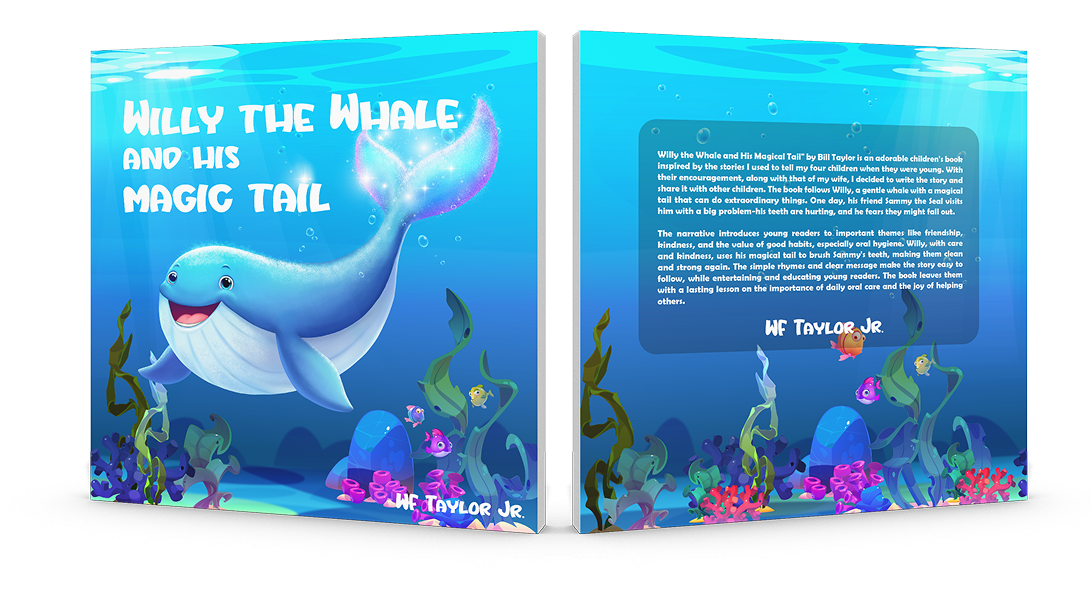
How Teachers Can Use Willy the Whale in the Classroom
When I first wrote Willy the Whale, I wasn’t just thinking about telling a fun story about a curious little whale. I was thinking about how stories can help children grow, not only in their reading skills, but in kindness, empathy, and teamwork. As a father, a grandfather, and a pastor, I’ve seen firsthand how kids soak up lessons when they’re wrapped in a story they enjoy. That is exactly why I believe Willy the Whale can be a wonderful addition to any classroom. Let me share a few ways teachers (and even parents at home) can bring Willy’s adventure into learning spaces and make it more than just a storytime book.
- Storytime That Sparks Conversation
Kids love listening to stories, but what makes it really special is the conversation that comes afterward. After reading Willy the Whale out loud, teachers can ask simple, open-ended questions such as:
- “Why do you think Willy helped his friends?”
- “What would you do if you saw a friend in trouble?”
- “How did teamwork make a difference in the story?”
When children talk about characters like Willy, they start to reflect on their own choices. It is a safe and fun way for them to learn about kindness and responsibility without it feeling like a lecture.
- Role-Play and Acting Out Scenes
One of my favorite classroom activities is role-play. Kids can pretend to be Willy, the crab, the starfish, or the dolphin. Teachers can assign each child a role and let them act out scenes where they have to help each other. This builds confidence and creativity, while also encouraging cooperation. Children absolutely love to “become” the characters. It gives them a chance to step into someone else’s shoes—or fins—and experience what it feels like to help a friend.
- Art and Drawing Activities
After reading, kids can draw their favorite part of the story. Maybe they will sketch Willy swimming through the coral reef, or the dolphin who needed help finding her way. Teachers can even make a classroom “ocean wall” where all the drawings are displayed together. This is not just fun, it also helps kids remember the story better. When children draw, they are retelling the story in their own way, and that helps the lessons sink deeper.
- Writing and Story Extensions
For slightly older kids, teachers can ask them to write or dictate their own “What happens next?” stories. Maybe Willy goes on another adventure. Maybe he meets new sea creatures who need his help. This activity improves writing skills while also encouraging imagination. Children love to come up with their own stories once they are inspired by a character they already care about.
- Connecting the Story to Real Life
One of the magical things about children’s books is that they can be bridges between make-believe and real life. Teachers can use Willy the Whale to talk about real sea animals, teamwork, or even ocean conservation. For example, after the story, teachers can introduce simple facts about whales:
- Whales are the biggest animals on Earth.
- They live in families called pods.
- They communicate with special songs.
This adds an educational layer to the fun. Kids love it when they realize, “Wow, Willy is like real whales in the ocean!”
- Building Social-Emotional Learning
At its heart, Willy the Whale is about kindness, empathy, and helping others. These are big words, but for children, they can be made simple through the story. Teachers can use Willy’s adventures to highlight:
Kindness: Helping friends in need.
Teamwork: Solving problems together.
Bravery: Facing challenges with courage.
By connecting these values to classroom behavior, teachers can gently encourage children to live out what they have learned from Willy.
- Group Projects and Collaboration
Another fun classroom idea is to create group projects inspired by the book. For example, children can work together to build an “ocean mural” with paper cutouts of whales, dolphins, starfish, and crabs. Each child contributes one piece, and together they become a beautiful underwater scene. This activity strengthens creativity while also mirroring the teamwork lesson from the story itself. Just like Willy and his friends, the children see that working together makes something wonderful.
- Fun with Music and Movement
Why not add music? Teachers can create a “Willy Song” where kids clap or dance like waves, whales, or dolphins. Movement keeps the energy high and helps little learners remember the story in a whole new way. When children act out swimming, splashing, or “singing like whales,” they connect emotionally to the story while having a lot of fun.
Read “Willy The Whale” Today!
 As the author of Willy the Whale, I truly believe that books are more than just words on a page. They are tools for connection, growth, and imagination. Teachers have the amazing opportunity to take Willy’s journey and use it as a springboard for reading, creativity, empathy, and teamwork. So why wait? Purchase Willy the Whale today and bring the magic of kindness, courage, and friendship into your classroom or home. Let’s dive into the adventure together and see where the waves of imagination will take us.
As the author of Willy the Whale, I truly believe that books are more than just words on a page. They are tools for connection, growth, and imagination. Teachers have the amazing opportunity to take Willy’s journey and use it as a springboard for reading, creativity, empathy, and teamwork. So why wait? Purchase Willy the Whale today and bring the magic of kindness, courage, and friendship into your classroom or home. Let’s dive into the adventure together and see where the waves of imagination will take us.